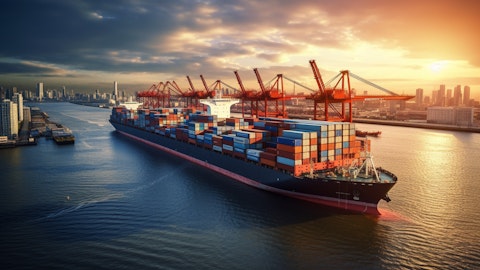Aris Water Solutions, Inc. (NYSE:ARIS) Q3 2024 Earnings Call Transcript November 5, 2024
Operator: Ladies and gentlemen, good morning and welcome to the Aris Water Solutions Third Quarter 2024 Earnings Conference Call. At this time all participants are in a listen-only mode. A brief question-and-answer session will follow the formal presentation. [Operator Instructions] As a reminder, this conference is being recorded. It is now my pleasure to introduce your host, David Tuerff, SVP Finance and Investor Relations. Please go ahead.
David Tuerff: Good morning, and welcome to the Aris Water Solutions third quarter 2024 earnings conference call. I am joined today by our President and CEO, Amanda Brock; our Founder and Executive Chairman, Bill Zartler; and our CFO, Stephan Tompsett. Before we begin, I’d like to remind you that in this call and the related presentation we will make forward-looking statements regarding our current beliefs, plans and expectations, which are not guarantees of future performance and are subject to a number of known and unknown risks and uncertainties and other factors that could cause actual results to differ materially from results and events contemplated by such forward-looking statements. You are cautioned not to place undue reliance on forward-looking statements.
Please refer to the risk factors and other cautionary statements included in our filings made from time to time with the Securities and Exchange Commission. I would also like to point out that our investor presentation and today’s conference call will contain discussion of non-GAAP financial measures, which we believe are useful in evaluating our performance. These supplemental measures should not be considered in isolation or as a substitute for financial measures prepared in accordance with U.S. GAAP. Reconciliations to the most directly comparable GAAP measures are included in our earnings release and the appendix of today’s accompanying presentation. I’ll now turn the call over to our Founder and Executive Chairman, Bill Zartler.
Bill Zartler: Thank you, David. Aris continued its strong 2024 with an excellent third quarter. We saw steady growth in produced water volumes and increased completions activity driving further demand for our recycled water. Our ongoing operational improvements delivered consistently strong margins and as forecasted, our third quarter capital expenditures were down significantly following the completion of our first-half weighted capital program. As a result of consistent volume growth, strong margins and efficient capital investment, we are generating excess cash, which allows us greater flexibility to both reinvest in the growth of our business and enhance shareholder returns. As anticipated, we’re seeing additional inorganic opportunities come to market and continue to evaluate a number of potential targets.
Our primary focus is on evaluating adjacent assets in our core operating area where we can drive incremental value and enhance our systems capabilities. Thus far we have not yet found an opportunity that offers the right combination of strategic fit, asset and contract quality and financial accretion that we look for and we will continue to remain disciplined while evaluating all potential opportunities. We want to thank our customers, suppliers, and our team for the strong results this quarter and great overall performance thus far in 2024. We’re encouraged by our continued progress and remain optimistic for the end of the year and beyond. With that, I’ll turn it over to Amanda.
Amanda Brock: Thank you, Bill. When we initially forecasted 2024 for investors, we had three primary commitments; to grow alongside our premier contracted customers; to improve margins by driving operational excellence; and to improve cash generation through greater capital efficiency. With the year largely complete, I’m proud to say, we have delivered thus far. We had an exceptional third quarter, growing our produced water volumes 2% sequentially and 6% year-over-year. As indicated last quarter in our outlook, we also saw a significant increase in completion activity in the third quarter, with recycled water volumes growing 25% sequentially and 16% versus the third quarter of last year. We continue to see consistent activity on our dedicated acreage in the core of the Permian Basin from our large long-term dedicated customers.
CPI-linked revenue escalation clauses in our contracts and structural operating cost improvements completed over the last year supported third quarter operating margins of $0.45 per barrel up 13% versus the third quarter of last year. While business mix flow back timing and skim oil recoveries can drive small quarterly variations in margins, we’ve maintained our improvement in margins over the past year, resulting primarily from electrification and enhanced operational efficiencies. Accelerating volumetric growth and sustained margin strength resulted in adjusted EBITDA of $54.3 million in the third quarter, up 9% over last quarter and up 21% year-over-year. In addition to operational improvements and cost reductions, our margins continue to benefit from increased skim oil recoveries.
We’ve improved our process for recovering skim oil and now believe a significant portion of the increased skim oil recovery is sustainable overtime going forward. While overall the trend is positive, we’ve also seen intermittent periods of elevated skim oil recoveries particularly related to flow back of large pads, and we believe there will continue to be some variability in recoveries quarter-to-quarter. Looking ahead to the rest of the year, we anticipate slightly increased activity levels from our customers and thus we are increasing our adjusted EBITDA range for 2024 from $208 million to $212 million. Consistent with our commitment to capital efficiency, we’ve outperformed our earnings while maintaining our capital guidance range for the year and are producing the resulting cash flow from our continued growth.

Looking at the market, despite commodity price volatility, we see steady to moderately increasing activity levels going well into 2025. Our growth is driven by operations on the dedicated acreage of our large long-term contracted customers in the Northern Delaware Basin, which features some of the lowest break evens in the lower 48 and decades of remaining inventory. The Permian and specifically New Mexico continue to lead oil production within the United States and based on initial forecasts received for the year, we anticipate sustained strong investment on and around our asset footprint. We will provide our full outlook for 2025 alongside fourth quarter reporting, but given the customer forecast received thus far, we anticipate growing produced water volumes next year at a pace consistent with our growth rate this year and consistent with overall oil production forecast for the Delaware Basin.
Our capital investment next year will depend on the growth rate of our contracted customers as well as incremental organic growth opportunities. Currently, we anticipate that we will be able to grow alongside our existing customers at a similar level of capital investment to 2024. In 2025, continued volume growth, additional margin progress and efficient capital investments will result in increased cash flow and we’re actively evaluating opportunities to reinvest in growth projects while also allocating capital to increase our shareholder returns. Beyond the cost reduction efforts we successfully implemented this year, we are reviewing opportunities to further improve margins. Looking forward, we have tailwinds from CPI revenue escalation clauses already embedded in our contracts and are pursuing further efficiencies in water handling costs, rental expenses and labor productivity.
For example, third party landowner royalties are our largest variable operating expense and we are now looking at opportunities to either accretively acquire surface acreage or partner with landowners to reduce these costs and provide us greater operational flexibility. Turning to beneficial reuse. We continue to collaborate with our project partners ConocoPhillips, ExxonMobil, Chevron and Coterra and regulators to accelerate the use of treated produced water outside of the oil and gas industry. By year end, Aris and its partners will have finished testing the third of three desalination technologies for the treatment of high salinity Delaware Basin produced water. The pilot projects thus far have successfully demonstrated the ability over time to lower energy consumption costs and potential capital and operating costs for the treatment of produced water.
In 2025, we will be focused on increasing the scale of these promising technologies and confirming costs as we progress to commercialization. We are also evaluating opportunities on mineral extraction and are working on site selection for our first iodine extraction facility with a strategic partner. In addition to iodine, we’re in discussions with several mineral extraction companies who specialize in magnesium, ammonia and lithium and are actively sampling and testing our produced water. We expect to have further updates to our mineral extraction efforts in 2025. And with that I’ll turn it over to Steve to discuss our financial results for the quarter and details on our outlook for the fourth quarter.
Stephan Tompsett: Thank you, Amanda. We recorded adjusted EBITDA for the third quarter of $54.3 million, up 21% from the third quarter of 2023 and up 9% sequentially from the second quarter of 2024 due to stronger produced water and recycled water volumes as well as higher skim oil recoveries. We achieved adjusted operating margin of $0.45 per barrel, up 13% from last year, but down just under $0.01 per barrel from last quarter due primarily to customer mix. While skim oil recovery and business mix can cause fluctuations quarter-to-quarter, we’ve demonstrated durable margin improvement over the past year due to improved operating efficiency and cost reduction initiatives. Turning to CapEx. With our first-half weighted capital program substantially completed, expenditures for the third quarter were $8 million, bringing CapEx for the first nine months to $83 million.
We are maintaining our full year 2024 capital guidance with expenditures for the fourth quarter expected to be between $15 million and $22 million, which puts us on track for $98 million to $105 million for the full year. Looking ahead to fourth quarter volumes, we expect produced water volumes to be between 1.08 million barrels and 1.11 million barrels per day, and we’re forecasting skim recoveries of approximately 1,550 barrels of oil per day. As Amanda mentioned, we’ve sustainably increased our skim oil recoveries and our fourth quarter outlook reflects an approximately 20% increase in recoveries relative to what we guided in the third quarter. In the Water Solutions business, we expect fourth quarter volumes to average 450,000 barrels to 490,000 barrels per day, continuing the strong activity levels we saw on our dedicated acreage in the third quarter.
For the fourth quarter we anticipate adjusted EBITDA of $51 million to $55 million, increasing our full year guidance to $208 million to $212 million. This outlook assumes fourth quarter oil prices of approximately $70 per barrel, which is down 10% from year-to-date realized prices and 2.5% to 3% above the current 2025 strip, which could offset some of the margin benefits we received from increased skim oil recoveries. With regard to our balance sheet, we ended the quarter with net debt of $422 million and a 2.0 times debt-to-adjusted EBITDA ratio, which is well below our leverage target of 2.5 times to 3.5 times and $325 million of available liquidity, which provides us with significant financial flexibility. Finally, we declared our fourth quarter dividend of $0.105 per share to be paid December 19th to shareholders of record on December 5th.
Given our ample liquidity, low leverage, growing cash flow and expectations for 2025, we anticipate revisiting our dividend payout level with our board after the fourth quarter. With that, I’ll turn it over to Amanda to wrap up.
Amanda Brock: Thanks, Steve. In closing, we again want to thank our customers, suppliers and team for their support, hard work and consistent execution. As a result, we’re proud to be exceeded our expectations thus far in 2024 and are encouraged by our outlook for the rest of the year and 2025. We remain focused on providing a safe place to work, delivering exceptional service to our customers, prudently growing the business and generating cash to both reinvest in the growth of our business and return to shareholders. We have built an incredibly strong foundation from which we will continue to grow. We’re excited about our future, enhancing water sustainability in the areas in which we operate and supporting the industry with innovative long-term water infrastructure solutions. With that, we are happy to take questions.
Q&A Session
Follow Ari Network Services Inc (NYSE:ARIS)
Follow Ari Network Services Inc (NYSE:ARIS)
Receive real-time insider trading and news alerts
Operator: [Operator Instructions] Thank you. The first question comes from the line of John Mackay from Goldman Sachs. Please go ahead.
John Mackay: Hey, good morning. Thanks for the time. I wanted to start on just kind of the early look into 2025. Pretty supportive commentary. Just wanted to maybe put a finer note on it. Are we looking at something like mid-single-digit volume growth on the produced water side and what are the puts and takes on kind of translating that to EBITDA? Thanks.
Amanda Brock: Thanks, John. We are not guiding 2025 and we intend to do that obviously when we come up with fourth quarter earnings. But as we’ve indicated, we believe that we’re going to see a range of sort of 4% to 7% mid-single-digit growth. We referred you to our customers and looking at what they have said about their growth. We always grow along side our customers and you’ve seen Chevron come out about reaching a million barrels next year, you’ve seen Conoco come out rather and talk about 7% growth. So we really sort of refer you to our customers and their commentary at this time.
John Mackay: All right, that’s clear. Thanks. And maybe just the comments around the disposal royalties. Can you just remind us what your position looks like right now and if you’re thinking about buying some surface acreage to complement that, just what the competitive dynamics are right now? Is it, is there a large market for surface acreage out there? Just anything you could frame up there?
Amanda Brock: So from a royalty perspective, I think people are beginning to understand the importance of the arrangement we reached a couple of years ago with TPLT [ph] where we became the preferred disposal partner and we had the ability to permit on their property and then drill those permits and we needed them, which obviously helped our capital position. We did not have to build ahead of need to maintain a permit. There is land out there. There are opportunities to own land ourselves and avoid royalties and also to continue to partner with landowners. So, I think we see both as options. We also have looked ahead. We have a long runway of permits in diverse locations that we can build as we grow our system. So we think we’re in a good position, but certainly we are looking at buying land, other opportunities to reduce our royalties as part of our cost efficiency and savings looking forward.
John Mackay: Thanks. Appreciate the time.
Amanda Brock: Thank you.
Operator: Thank you. The next question comes from the line of Jeffrey Campbell from Seaport Research Partners. Please go ahead.
Jeffrey Campbell: Good morning, Amanda, and congratulations on the strong quarter.
Amanda Brock: Thank you, Jeff.
Jeffrey Campbell: I wonder if you could provide us with a regulatory update. In particular, how is disposal of produced water and surface systems progressing in Texas and is it reasonable to assume that once approved this would be a less costly disposal method for Aris as opposed to injecting water underground?
Amanda Brock: I think you’re referring to beneficial reuse. Going forward, there will always be disposal in Texas. And as we are looking at beneficial reuse as an alternative to disposal, so are our customers. When you look at the share volume of water that we will be handling as an industry going into the future that is generated in the Permian Basin, you will continue to see opportunities to expose, to continue to develop beneficial reuse an alternatives and to look at any other method that can help with the handling of this water. I hope that answered your question. I was not quite clear on the question.
Jeffrey Campbell: Well, let me try again. I’m sorry, I wasn’t clear enough. There’s been some discussion in, Texas of allowing the disposal of produced water into surface systems like say the Pecos River or maybe some lakes or something like that. And I was wondering if that’s continuing to progress. And I imagine being able to put large volumes of water in the Pecos River would be cheaper than having to dispose of the ground, but maybe that’s incorrect. So that was what I was trying to go.
Amanda Brock: Thank you for the clarification. Certainly there are opportunities working with the regulators and applying for the appropriate permits for surface discharge into the Pecos River. That is an alternative. We are actively looking at that, as are others. And I think you will see that continue to progress over the next year.
Bill Zartler: I think maybe to add a finer point to that, the salinity of the produced water and especially the Delaware Basin is way too high to direct inject it. So it will be required to process it in a way to clean it up. And that will always leave some level of concentrated brine, even if you run it through and end up with water that’s of the quality that we believe can be discharged into the surface waters.
Jeffrey Campbell: Okay, now that was very helpful. Thank you. The another question I wanted to ask was on Slide 9. I just wondered if you could expand on what Aris and JIPs financial responsibilities will be with relative to the 2025 substantial capacity scale up and beneficial reuse. And I’m asking that question because with the iodine, it’s a royalty arrangement and they’re paying the capital cost. I’m wondering if it’s going to be different in what you’re visualizing for 2025. Thank you.
Amanda Brock: Thank you. So as we look at 2025 and continue to work with our JIP partners and adding partners to that consortium, we are looking at identifying a specific technology and we have an idea now which one it is. That’s extremely promising from a CapEx, OpEx and energy usage perspective. And then scaling that up as it relates to our capital commitment in 2025, it will not be material. We will continue to share costs with our partners that many of our costs as it relates to allocation of personnel is reimbursed. So and as it relates to the iodine project, we have talked before about not spending any capital and about doing that on a royalty basis where our partner spends the CapEx for the infrastructure related to the extraction of the mineral.
Jeffrey Campbell: Okay, great. Thanks very much.
Operator: Thank you. The next question comes from the line of Wade Suki from Capital One. Please go ahead.
Wade Suki: Good morning, everyone. Appreciate for taking my question. Clearly you all remain pretty busy on the commercial front. Always appreciate the color you all provide on both organic and organic opportunities. You mentioned maybe adding customers in the basin. Presumably that’s in the same zip code, but again, any kind of color you could get would be great. Thank you.
Amanda Brock: Thank you, Wade. Yes, we continue to be very active on the commercial front. We have great individuals; we’ve talked about them before on the commercial team who work actively with our existing customers as we continue to grow alongside them as they expand on their acreage, as well as working with potential new customers as they begin to move into manufacturing mode on their acreage. We have been working with some customers and anticipate signing some contracts in the future and we will continue to do so. So, yes, Wade, we continue to see a pretty robust market out there to grow with our great customers and new customers that are expanding their operations.
Wade Suki: Fantastic. And then just kind of switching to inorganic. Anything you can sort of share with us on expectations out here, buyer, seller expectations, bid ask spread. Have we seen that narrow at all? Or has it been pretty sticky since the last update?
Amanda Brock: That’s a great question. We’re always hopeful that we’ve been very disciplined. Bill, why don’t you take that?
Bill Zartler: Well – it’s hard to say whether they’ve gotten any narrower on the bid ask spreads. They certainly hadn’t met yet.
Amanda Brock: I mean, we continue to look as we’ve talked about, Wade, but we’re looking for projects where secretive, where they’re strategic, where we can do more with the assets and a great asset and contract quality. So we continue to look and hope that we will be able to find an asset that meets our criteria.
Bill Zartler: Wade, I’ll add there, we are very comfortable with the current contracts we have, the ones that we’re pursuing aggressively, and comfortable with the state of our assets, how we built them and how we’re maintaining them. And so I think we have set our own standard and have yet to find anything that fit that, as we said in the remarks, both on a financial perspective as well as a asset and contract quality perspective.
Wade Suki: Understood. Thank you so much. Appreciate it.
Amanda Brock: Thanks, Wade
Operator: Thank you. The next question comes from the line of Praneeth Satish from Wells Fargo. Please go ahead.
Praneeth Satish: Thanks. Good morning all. Does the mid-single digit growth outlook for produced water in 2025 that you provided, does that assume the addition of some of the new customers that you just referenced that you’re in discussions or talking to? Or is that just based on your existing customer base and the growth plans that they provided to you at this point?
Stephan Tompsett: Yes, Praneeth, good morning. Thanks for the question. And as Amanda said, we’re not providing 2025 guidance at this point. And in fact, we don’t have full year forecast for most of our customers in detail. But at this point, this is for existing customers, existing contracts. What we do have visibility on into the first part of the year and expectations on for [indiscernible].
Praneeth Satish: Got it. No, that’s helpful. And then maybe just touching on the dividend. Sounds like you’re going to have discussions with the Board later this year, in terms of how to think about the growth next year, are you, just in terms of the framework of how we should think about it, are you considering dividend growth in line with organic EBITDA growth? Or might you pursue a more significant step up or step change given the current payout level and low leverage?
Stephan Tompsett: Yes, that’s a great question. And we do remain consistent in our approach to capital allocation that we’ve laid out in the past. And what we want to do is increase shareholder returns in a consistent, sustainable manner over time. So as we did indicate in the prepared remarks, we do expect some additional color that in Q1. I expect there’ll be some dividend growth. I don’t expect a step change that’s going to put us out of line with the growth of the business. So we’re looking at long-term sustainable growth.
Praneeth Satish: Got it. Thank you.
Operator: Thank you. The next question comes from the line of Jeremy Tonet from JPMorgan. Please go ahead.
Noah Katz: Hey, this is Noah Katz on for Jeremy. First, I wanted to touch on your capital allocation priorities heading into 2025 now that Aris has lowered below the 2.5 times to 3.5 times target at two times currently. How would you guys stack rank, accretive M&A opportunities or the potential dividend raise you’re speaking of and repurchases going forward? Thanks.
Stephan Tompsett: Noah, thank you for the question. As I said, we remain consistent in the capital allocation framework that we’ve laid out and we’ve touched on M&A. We would like to look at attractive fees opportunities where they meet our criteria, but we haven’t found those as of this time. We have considered share repurchase program, but given the limited float that we have, we decided to pass on that at this time. That is something that we’ll continue to evaluate. And as we also indicated, there are some additional growth projects that we’re looking at for new customers. But I think you should expect us to be consistent more the same what we’ve delivered.
Noah Katz: Sounds good. Thanks for that. And then as a quick follow up, can you guys speak to the potential you see for the desalination and mineral extraction projects? Should we expect any other projects coming up the pipeline like these? Thanks.
Amanda Brock: Thanks, Noah. What we have consistently emphasized is that we are very focused on our core business and that is important for everybody to have comfort in that fact. We are continuing to look at the future for beneficial reuse. We think that we will finish out the project next year. We will begin to scale up and I think it is very promising. But we are not planning on at this time on additional projects coming in that are other than the projects we’ve been discussing. We are looking at industrial water. We have developed tremendous capability and expertise and a thousand patterns in and the treatment of complex water. So we are exploring opportunities in the industrial sector. But again, most of our attention is our core business and making sure that we perform.
Noah Katz: Thank you.
Operator: Thank you. The next question is from the line of Charles Bryant from Citi. Please go ahead.
Charles Bryant: Hi, just one from me. There was some news headlines around a new setback rule in New Mexico that could come into play. I know this can pop up from time to time and it sounds like maybe not much to do around it, at least for now, but curious how you think about the potential impact there if something like that does come into play.
Amanda Brock: When New Mexico did raise the idea of legislating setbacks, a lot of our customers looked at that and have actually gone out and permitted and have adjusted some drill and rig schedules in making sure that if they were going to be impact that they were appropriately positioned so we do not see an impact on our business. And it will be interesting to see how that legislation moves forward this next session.
Charles Bryant: Okay, understood. That’s all had. Thanks for the time.
Amanda Brock: Thank you.
Operator: Thank you. The next question comes from the line of Sean Mitchell from Daniel Energy Partners. Please go ahead.
Sean Mitchell: Good morning and thanks for taking my question. Happy Election Day.
Amanda Brock: Thank you.
Sean Mitchell: You guys talked. Yes, you guys talked in the opening comments about improving skim oil recoveries. Amanda, can you provide more color around what you’ve done to improve that process? It seems like a pretty nice increase and it looks like that’s going to kind of included in your guidance going forward.
Amanda Brock: Certainly, what we have done is allocate a team that is dedicated to doing nothing else in the field but skim oil recovery. So it really has been a function of focus and going out into the field. We have made operational changes, but I think it’s really the allocation of people. But in addition, we have seen some increase in skim that is coming through in the water, so I think it’s a combination.
Sean Mitchell: Okay, thanks for that. And if you’re coming out for the barbecue, bring your coat. Its 42 degrees.
Amanda Brock: As long as it’s not raining.
Stephan Tompsett: You’re missing the rain in Houston this morning, Sean.
Amanda Brock: Thanks, Sean.
Sean Mitchell: Yep. See you guys tomorrow, probably.
Stephan Tompsett: Thanks.
Operator: Thank you. As there are no further questions, I would now hand the conference over to Amanda Brock for her closing comments. Amanda?
Amanda Brock: Thank you. I want to again thank our customers, suppliers, and very importantly, our team that continues to execute extremely well. We’re growing. We’ve improved our margins, which improve cash generation. Our balance sheet is in great shape. We feel good through year end. It’s setting us up well for 2025 and beyond. So thank you all, and we look forward to talking to you shortly.
Operator: Thank you. The conference of Aris Water Solutions has now concluded. Thank you for your participation. You may now disconnect your lines.
Follow Ari Network Services Inc (NYSE:ARIS)
Follow Ari Network Services Inc (NYSE:ARIS)
Receive real-time insider trading and news alerts





